With endless depictions of Vikings in movies, shows, and games, it can feel like we have plenty of imagery to call upon when imagining a ship full of Viking warriors.
But what did the Vikings look like – really? As you’ll see, even in the most accurate portrayals, the reality of what Vikings looked like doesn’t quite match up with what’s always on the screen.
Finding out typical Viking traits, features and characteristics has been the subject of much study by archaeologists and researchers – as we’ll explore below.
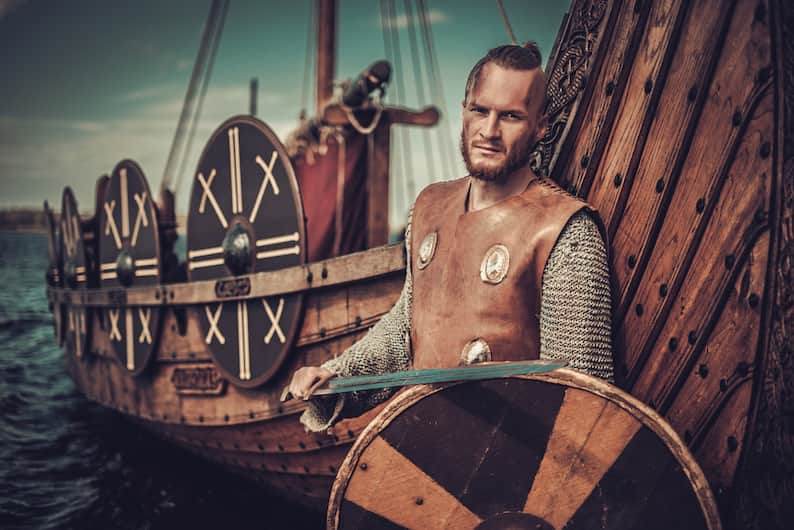
Table of Contents
What did the Vikings look like?
Overall, Scandinavians had softer brows and jawlines during the Viking Age. Fair hair and complexions were common, but not ubiquitous. Dark hair was common, and red hair had a higher prevalence in Norwegian Vikings compared to the general population of Europe. For all seafaring Vikings, physical size and strength was typically beyond that of other cultures.
Vikings had a wide variety of backgrounds throughout the Viking Age, so any Viking could have a unique appearance. That said, the core Scandinavian Viking traits were shared with each other and cultural ones with those who joined their society.
Get the ultimate Viking hair and jewelry set
81 piece set of beads and pendants featuring Norse Runes – for braids, beards, bracelets, necklaces and any other Viking-inspired look you can think of

It’s possible to generate a fair idea of what Vikings looked like from the available archaeological remains, but there may be missing details lost to time. First-hand accounts from the time are limited, coming largely from Islamic scholars like Ahmad ibn Fadlan and Christian monks. Viking artwork was not photorealistic, centering more on ornamental additions to household objects, so only loose details can be gathered from most examples.
Hairstyles were not uniform, but they were typically long with an accompanying beard. Braids and dreadlocks on Vikings were not common despite media depictions. For the roving Vikings, they would let the hair stay long in front, but the back was kept shaved to remove a potential handhold for enemies.
Related: Did Vikings Have Tattoos (and What Were Their Meanings)?
What did Vikings wear?
Instead of drab earthen tones and animal skins, Vikings were fond of color and accessories in their tunics and trousers. Natural materials were dyed with plants, like woad, to add color, and they traded for rarer colors of cloth like purple and red.
Did you know: Scandinavians were weaving together fabric well before the dawn of the Viking Age. A chieftain was buried around 600 CE in an ornate coat of mahogany and green, complete with animal depictions woven into the front and collar.
In battle, Vikings would likely have worn mail or leather armor with a sturdier iron helmet. Despite what we see in pop culture, Vikings didn’t actually wear horns on their helmets. Instead, their association with Vikings would not come for hundreds of centuries in the work of the opera composer, Wagner.
They also wore more protection than many Viking depictions, but heavier mail and better quality armor were more expensive items reserved for more successful Vikings.
What did Viking women look like?
Scandinavian women from the Viking Age were more similar to males in facial structure and skeletomuscular strength. When looking at facial structure, female Scandinavians had an austerity and firmness more commonly associated with masculine faces. Archaeologists report an easier time identifying the sex of the skeleton based on pelvic bones, but DNA testing is preferred for verification.
More rigorous physical demands from a self-sufficient lifestyle would contribute to larger, more muscular builds. Women were as likely to participate in Viking adventures as men, making up a fair portion of Viking populations in far-ranging settlements.
Like the Viking men, Viking women would keep their hair long. The most common depictions are ponytails drawn together by intricate knots of hair at the base. The striations in the hair of one depiction has been frequently used as evidence for hair braiding by Vikings, but the small statue and representational nature of Viking artwork makes it inconclusive without other evidence.
Related: Did Viking Face Paint Exist?
What did Viking women wear?
Women and men had similar tastes in apparel, including a fondness for colors and accessories. Ibn Fadlan described each woman as wearing brooches on her chest and necklaces based on the wealth of her husband. Instead of tunics and trousers, women wore simple dresses with shoulder straps made from the same dyed materials as the men’s clothing.
Fashion trends would have varied over time and between regions, but a love of the shiny, colorful, and beautiful was absolutely a part of the overall Viking culture, including jewelry although the jury is still out on Viking piercings.
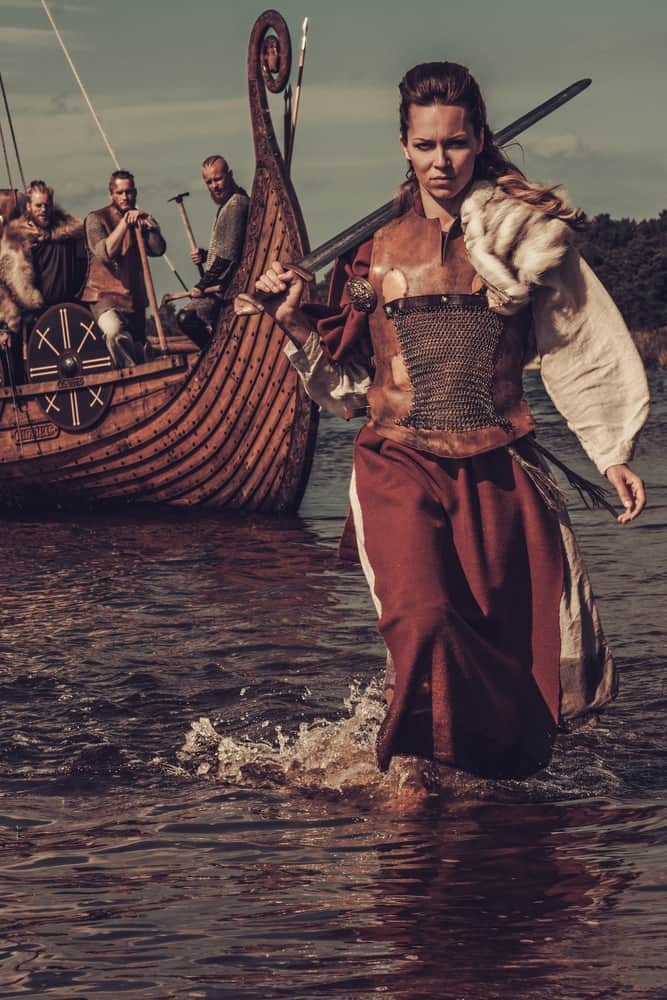
At the same time, functionality was key, especially in times of war. Those who served as shield-maidens would have dressed similarly to male Vikings in battle where function trumped form.
Although archaeological evidence for shield-maidens is limited, with more evidence for all-male parties, shield-maidens that have been discovered had the same assortment of equipment in their burial sites that would be seen in a male Viking warrior’s grave. Since DNA evidence was ultimately responsible for determining the gender of the body, there may be more corpses that were presumed male and are awaiting a closer look to reveal their true identity.
What race were Vikings?
Vikings originated in countries that are now known as Denmark, Sweden, and Norway, but they did not maintain distinct racial lines in their culture. Anyone who proved their worth could have ended up a Viking, whether by force or by choice.
The Viking Age was a period of increasing mobility, and the wandering bands of Vikings were a pivotal driving force in the rapid dissemination of people across the world.
Even the first group of settlers into Scandinavia had varied origins, although Europeans traveling north made up the majority of the cultures that became the Vikings. Uralic migrants from what is now Russia came west, but they typically only ventured as far as places like Finland and Lithuania (although some there is evidence that Vikings were in Finland, meaning they could have mixed that way).
The separation of the Viking cultures
The question becomes even more difficult when you consider the particulars of the Viking expansion, like the Swedish Varangians who founded the city of Novgorod in modern-day Russia. After Scandinavia was settled, the populations had less intraregional migration. It wasn’t unheard of for Scandinavians to move about the region, but further travelers were just as common despite the tougher journey.
This separation remained within the various Viking subgroups throughout the Viking Age, with the Danish, Swedish, and Norwegian Vikings tending to group together. Voyaging parties were usually made up of those who knew and trusted each other, and there was no Viking Twitter to facilitate long-distance flash raids.
Instead, each set of Vikings set off on their own independent adventures, leading to distinct differences when researchers investigated the burial sites both inside and outside of Scandinavia. The subgroups were just as likely to raid each other as they were to raid far-flung shores, given the opportunity for plunder.
The Viking expansion
Those de facto lines did not extend to the other cultures that the Vikings contacted. Once the Vikings came to an area, people from that region would inevitably find their way into the culture. Some would willingly join, and others were taken as slaves. Viking influence was powerful around the Baltic Sea and rivers leading deep into Eastern Europe.
The Sami had a presence and place within Viking society that was different from many others. They are the primary inhabitants of the northern stretch of Scandinavia, where they subsist on hunting and reindeer herding to this day. While they remain a distinct ethnic group, researchers discovered Sami remains buried in traditional Viking fashion.
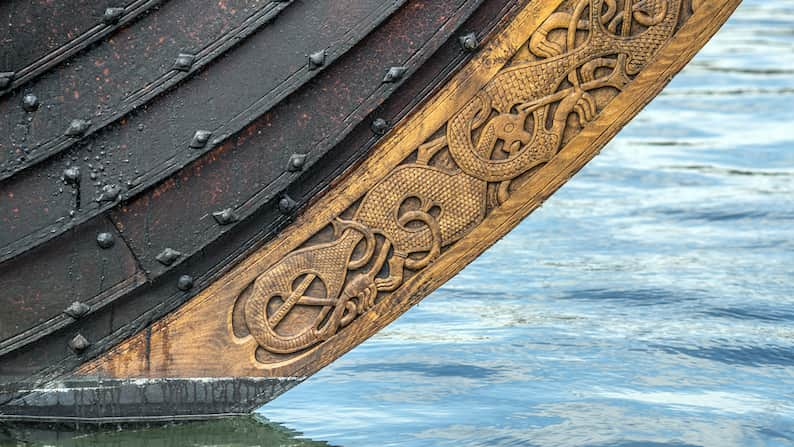
While ruling out violence entirely is impossible, the Vikings had a more peaceful relationship with the Sami compared to their foreign conquests, trading with some and taxing others as vassals.
Later burial sites included Scottish and Irish Vikings who showed no signs of Scandinavian heritage. At another site, the men were predominantly Norwegian Vikings, while the women were from the British Isles.
Looking at the genealogy of bodies excavated from Sigtuna, a city founded in the twilight of the Viking Age, reveals some of the extent of the migration. Half of the group was confirmed to have been relatively recent immigrants to the area. Some came from other areas of Scandinavia, while others traveled long distances to reach the area.
Find out more: Did Black Vikings Ever Exist?
The aftereffects of Vikings on race
Although the growing trade patterns meant slaves and additions to the Viking cohorts could have come from anywhere, the separation of the Viking clans did have overarching effects on how they joined with other cultures.
Norse Vikings had a stronger presence in Greenland, Iceland, Ireland, and several islands north of the British Isles. The Danes were fond of the western coast of Europe, following it all the way through the Strait of Gibraltar and into the Mediterranean Sea. The Swedes pushed further east and south, following the rivers of the Baltic coast down to the Black Sea.
FYI: A study by a DNA testing company showed that Norse Viking DNA is present in 1 of 33 U.K residents, with a notably higher concentration in the northern part of the isle. The Swedish Vikings played a role in the growth of the Swedish Finn population, though the height of the influx came after the Viking Age.
Not all of the journeys followed this trend. A woman with mtDNA markers more common to Byzantium, where modern-day Turkey is, was discovered in a Norwegian gravesite. The same DNA study that supports the split migration patterns also discovered markers that buck the trend. For every indication of a pattern, there is a piece of evidence that subverts it.
To come back around to the original answer: Vikings were primarily Danes, Swedes, and Norsemen – but a Viking could have been from any race of people given the reach of their raiding and trading.
Did Vikings have beards?
Most Viking men would have grown beards, and it could be considered one of the core Viking traits for appearance. Exceptions may have existed for those who couldn’t grow beards or came from different cultures.
In the same way that Viking combs point to them caring for their hair, a lack of trimming tools for hair shows that they may have frequently let it grow long. A knife could be used for shaving, but it’s not the best tool for cleanly cutting a beard. Styling the beard as it grew and shaving other areas would have been easier, although some would have kept it shorter.
While Viking artwork is not the best for details, it can show us whether or not certain people had beards. Statues and artwork of Viking leaders like Erik the Red and Rollo showcase their facial hair, although each has their own length and style. Rollo’s beard touches his chest, while Erik is shown with a shorter beard and an oiled moustache.
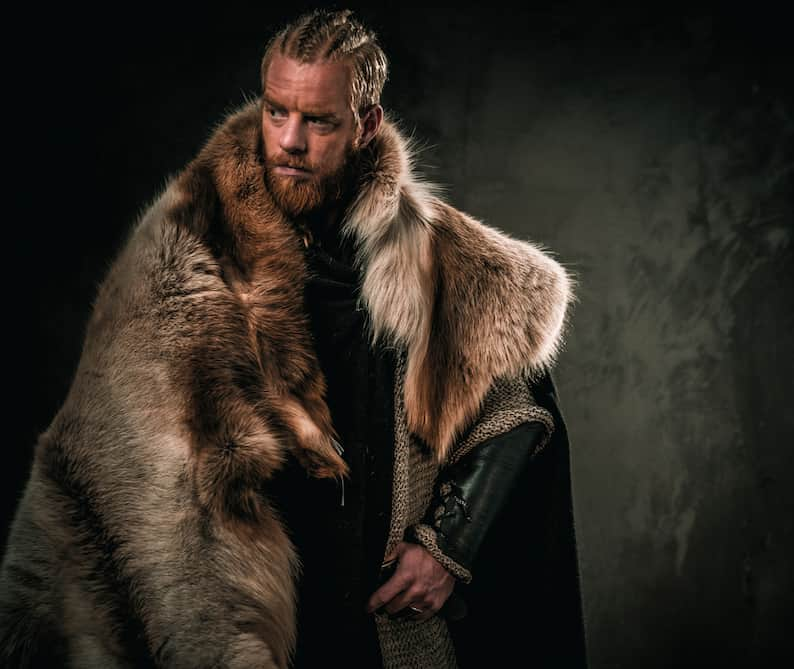
Why did the Vikings have beards?
A combination of cultural and environmental forces likely reinforced the commonality of beards among the Vikings. Coming from a colder climate, a beard would have helped retain heat. A thicker beard can keep a face even warmer, so a preference for big beards could have been reinforced as more men wore longer beards.
The exact source of the tradition predates the Viking Age, and its natural development could have influenced its adoption in several places at the same time. With a lack of first-hand accounts as to why, we are left speculating for now.
What color eyes did Vikings have?
Scandinavian Vikings were more likely to have blue eyes, even if an exact breakdown of eye colors is impossible to give. The image of stark blue eyes surrounded by dark kohl is a common refrain in media depictions, and this holds mostly true, even if Vikings had a variety of eye colors.
The personal account of Ibn Fadlan details his voyages with the Varangian Rus, a group of Swedish Vikings operating deep into the heart of Europe. He seems enamored with the smoky Viking makeup around the eyes that we also now see in TV shows, but he doesn’t specifically mention their eye color. It’s impossible to know whether that’s because they didn’t have blue eyes or he forgot to do so.
Modern statistics do not exactly mirror ancient times, but they can lend a helping hand in this situation. 64.84% of the population of Denmark has blue eyes, and only 14.5% have brown eyes. Assuming a similar distribution, blue eyes would have been the norm, but seeing other eye colors would not be a shocking incident in Viking society.
What color hair did Vikings have?
It’s likely that Vikings were mostly blond given that Scandinavians have a high percentage of blonds, but dark and red hair do make up a substantial part of the population. When including non-Scandinavian Vikings, the actual percentage of blond Vikings may have been lower than today.
Like the myth of every Viking having steely blue eyes behind their helmet’s visor, Vikings charging into battle with a head of blond hair is true – to a degree. Calling back to Ibn Fadlan, he describes that the Vikings are all blond and ruddy.
It’s not a detailed demographic breakdown, but it at least supports the idea that when it comes to what did the Vikings look like, a group portion of blond heads seems possible, even if Vikings with red hair may have been more prevalent.
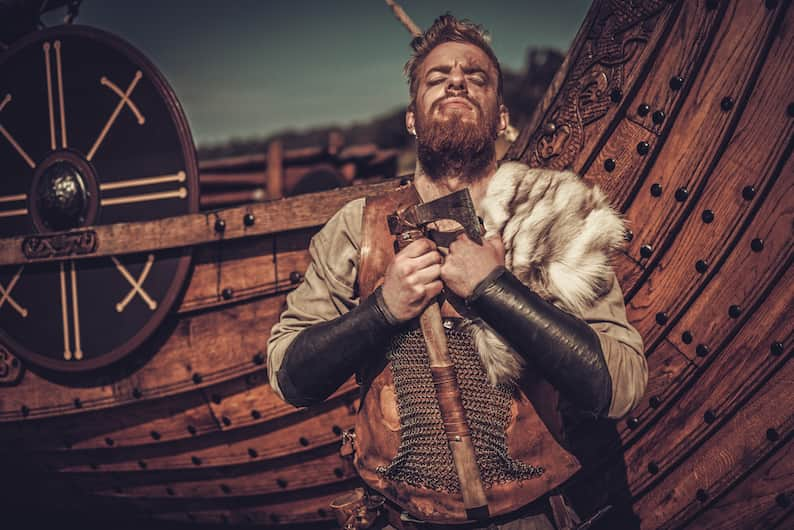
Pulling from the study that detailed eye color in Denmark, we can see that over 60% of the country has blond hair. This does constitute a moderate majority, and there is a possibility that the density of blonds has decreased over time.
A large genetic study showed that Vikings remained split within their regional groups. Norway had a higher concentration of redheads than the world average, and that holds true to this day. Even with a higher percentage compared to other regions, current numbers are at around 6% of the Norwegian population and 5% of the Danish population, making red hair uncommon if not rare.
It’s also important to know that the ancient Vikings were people like us with their own vanities, so many were not satisfied with the natural color of their hair. If they thought their hair was too dark, they may have used a bleaching agent created from wood ash to make it lighter.
You may also be interested in: Did German Vikings Exist?
What was the average size of a Viking?
Ibn Fadlan described each of the Vikings, who he called Rusiya, as being as “tall as date palms”. Considering a date palm can reach 75 feet tall, the statement is hyperbolic but does support a larger than normal height for Vikings. A reasonable estimate puts the height of the average Viking at 69 to 70 inches.
People of the time were experiencing a growth spurt over their ancestors. A global warming period increased the growth of crops as farming techniques and technologies improved. The average height across all of Europe was about 68 inches (around 173 cm) during the Viking Age, but it would drop to barely over 65 inches (165.1 cm) during the Medieval Era, when a minor ice age chilled the planet.
Some of the perceived height of Vikings could be attributed to selection bias, where the tallest and strongest Vikings were the most likely to go forth to trade and raid. Looking at modern average heights per country, Denmark and Norway still sit in the top 4 at an average of 71.89 inches and 71.81 inches, respectively.
How heavy were Vikings?
Given that Vikings had healthy and satisfying diets with a decent height for their era, we can reasonably assume a slightly above average Viking warrior would be around 5’10” with a stocky build. Current data suggests that this would result in Vikings weighing from 183 pounds (83kg) to 270 pounds (122kg).
Determining how much a Viking weighed from skeletal remains is more difficult than telling how tall they were. A decent approximation can be made based on their height, diet, and lifestyle.
While not a scientific source, this Men’s Journal report suggests that a physically active male around that height would have the weight range mentioned above. With their diet and size, a Viking could reasonably have weighed within this band, especially given their reputation for strength and size.
How physically fit were the Vikings?
Vikings undoubtedly had high muscular strength, especially those who ventured for trade and plunder, but they may not have been the best runners overall due to their size and focus on water-based travel. Venturing far from the boat was a tactical blunder that the Vikings did not commit often.
Since the Vikings did not keep records of physical fitness exams, we are once again left speculating based on the available information.
Although we don’t know what every Viking was physically capable of doing, their strength and fitness can be fairly confidently assumed. Rowing was a constant in Viking life as they ventured up and down the coasts and rivers. Partying and cavorting were some of their favorite downtimes, but they spent as much time on physical activities like wrestling and fencing.
For those who did not lead such a physically demanding life with access to ample food, the Vikings could have seemed impossibly strong and larger than life. When the Viking raid came to town, it’s understandable that the common people of the time would see them as hulking monstrosities.
How did the Vikings get so big?
Vikings were encouraged to stay well-fed and exercise and Scandinavian diets were (and are) heavy on carbs and proteins, two key ingredients for growing big and putting on muscle. One’s size is also largely based on genes and the fact Scandinavian populations today tend to be tall suggests the same was true in Viking society.
That is, height and weight are determined by a combination of two factors: genetic makeup and environmental factors. Food availability is a major component of the environment, as is lifestyle, disease, and climate. Someone with the best diet in the world may not reach 6′ tall, but someone with no food won’t grow much at all.
Scandinavians were slightly taller than many nearby people, but the variety of backgrounds within Viking society points to a strong cultural influence as a leading environmental factor. Vikings were encouraged to stay well-fed and exercise both their bodies and their wits. The Havamal provides one of the few written glimpses into the cultural practices and norms for Vikings, including such sound advice as eating and cleaning before going to a big meeting.
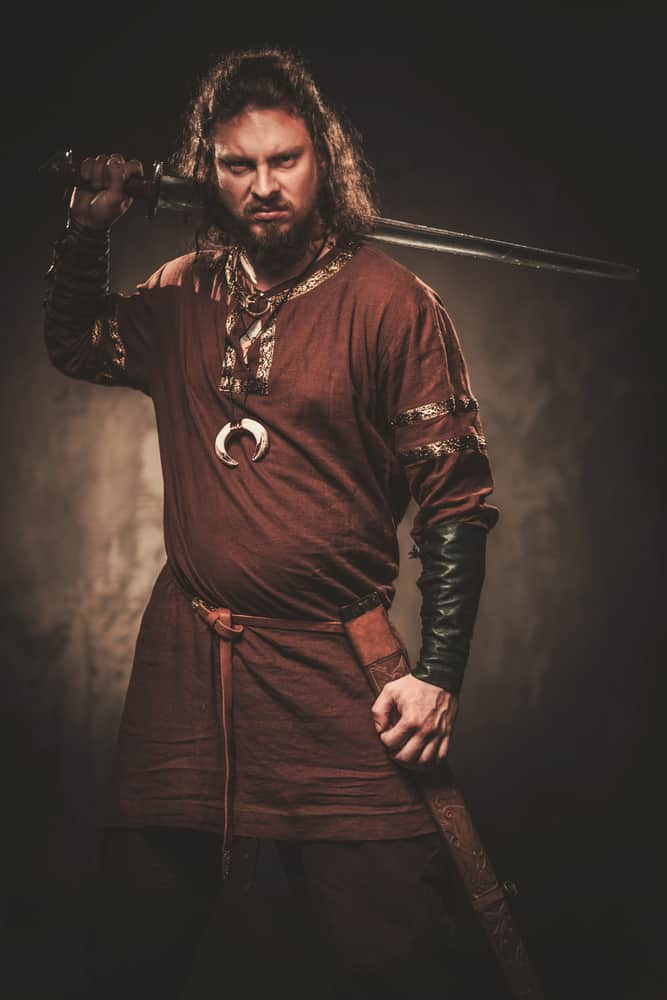
For the Vikings, fish from the rivers and seas, particularly herring, were always a welcome addition to a meal. Scandinavians also practiced farming and ranching, so pork was another common meal. Wild game supplemented the meat supply, and they even considered horse meat to be an acceptable food.
Just lying around and eating won’t turn a person into a muscle-bound barbarian, but the Vikings were always wrestling, fencing, hunting, farming, or otherwise engaging in rigorous physical activity. A lifestyle full of heavy work builds up muscles consistently over time. Even non-Scandinavian Vikings would benefit from the eating and lifestyle habits.
The continued presence of higher than average height in Scandinavian populations fulfills the genetic portion of the formula. The right blend of circumstances came together to produce sizable Scandinavian Vikings at a time when physical strength and size were considerably more valuable. Their military and trade prowess likely fed into the overall perception of being larger than life.
Why did Vikings file their teeth?
Remains of two dozen Viking Age bodies showed signs of significant and intentional dental modifications. Several of the front teeth have been filed horizontally into precise rows. The exact reason why these Vikings filed their teeth remains unclear due to the limited number of remains and follow-up research.
To speculate from the bodies that were found, the filing may have been for aesthetic purposes and accompanied by painting. It’s also possible that it was a rudimentary form of dental surgery. A group may have used it as a way to indicate membership in a way that is permanent but subtle.
Hopefully, future finds will shed more information on their reasoning.
What was Viking hygiene like?
Vikings had some hygiene habits that we might see as unclean by today’s standards, but they were relatively fastidious for the time. Their hygiene involved frequent washing and grooming, often daily, with their long hair and beards being maintained through rigorous combing.
In fact, the prevalence of combs in Viking archaeological sites has provided a number of clues into the world at that time. The materials and decorations are important, but the combs’ practical use was employed by a majority of Vikings.
Traditionally, the Vikings fully bathed on Saturday. Within the Scandinavian languages, this strong association can still be seen in modern words for Saturday that are derived from the original name for this Norse day of the week, Laugardagur.
Related: What Language Did the Vikings Speak? (Ultimate Guide)
Once a week might sound like a long time between baths, but Christian cultures at the time were directly advocating against bathing. That also doesn’t include less rigorous washing done throughout the week, so a Viking would have smelled comparatively fresh to other Viking Age cultures.
Not everyone was as enamored with Viking hygiene, though. In Ibn Fadlan’s Risalah, he declares his disgust at the particulars of their washing habits. He mentions a face-cleaning ritual where the Vikings share a washing bowl as foul and unclean. However, it’s worth keeping in mind that Islamic cleanliness rituals were much more strict and encoded, likely playing into Fadlan’s visceral reaction to their habits.
His complaints aside, the account corroborates that Vikings had regular hygiene practices that were shared and encouraged amongst them. They probably had potent natural smells throughout the week, but they didn’t let themselves waste away in filth. Like any modern soldier who keeps a bunk ready for white glove testing but might get dirty in the field, Viking hygiene would likely suffer during periods of high activity with no time to rest.
Facial reconstruction of Vikings
Viking facial reconstruction has limitations, but the techniques used can still give us a fair idea of what someone from thousands of years ago might have looked like. Finer details like blemishes, coloring, and surface-level changes are inferred from a mix of bone structure, genetic testing, and assumptions about the corpse.
The field is still relatively new and undergoing new advances all the time, but these two examples feel like staring into the past.
Ludvig, the Ancient Scandinavian
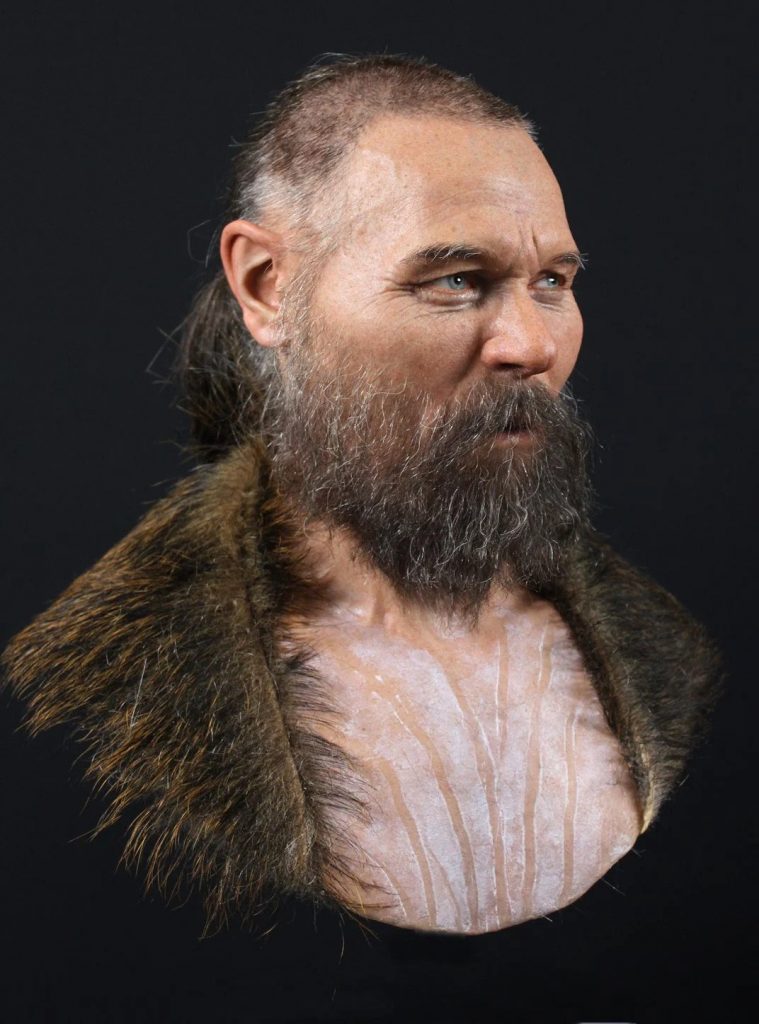
This first reconstruction ventures far back before the Viking Age to roughly 6000 BCE. The man had a particularly gruesome end, even for a more dangerous and primitive time. His head was removed and planted on a stake, an early example of intentional decapitation in Europe.
Either time or mistreatment caused him to lose his jaw, so liberties had to be taken with the bottom portion of his facial structure. The beard covers up the majority of it, so it doesn’t take away from the early indications of the softer brow seen in Viking Age men. The hair on top of his head is not in any Viking fashion, but the artist specifically noted taking inspiration from the boar hide that was found with the body.
Erika the Red, Shield-Maiden
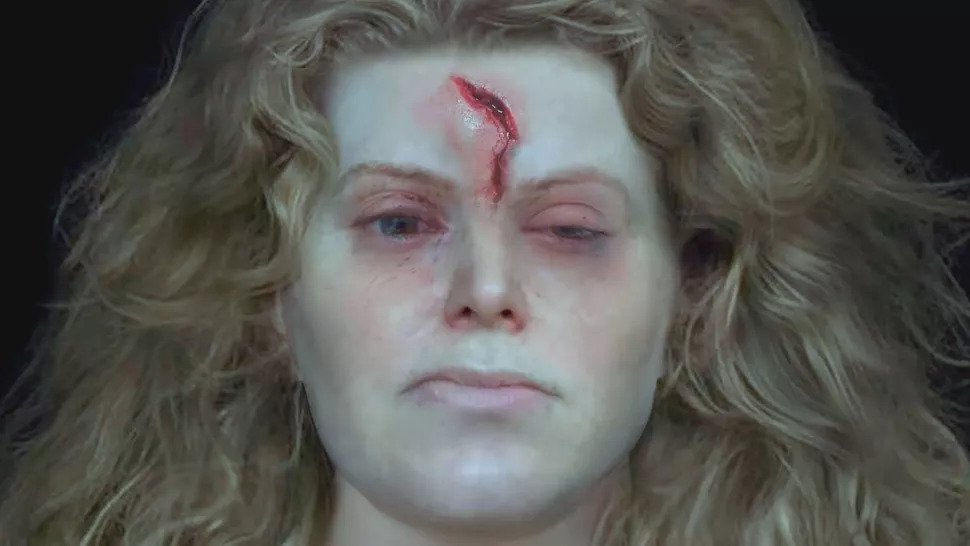
In 2019, researchers finished the facial reconstruction of a female Viking. Between the ample amount of weaponry in her grave, the battle scar on her face, and the young age of her death, it is exceedingly likely that she led a Viking warrior’s life.
Looking at the image of the reconstruction, you can see some of the traits mentioned earlier about the appearance of Viking women. Her jaw is broad and firm, and the forehead wound only enhances her imposing visage. She still has a feminine beauty, but she also looks like she could take your head off with an ax.
Her actual identity is unknown, but The Guardian supplied a clever moniker in ‘Erika the Red’. While we may never know who she was, her face can stand in for the rest of the shield-maidens until they are no longer lost to history.
